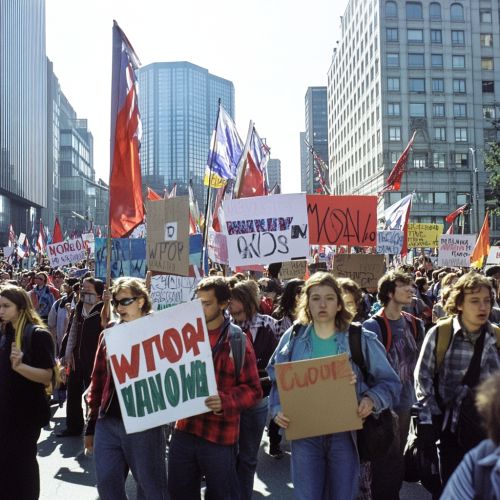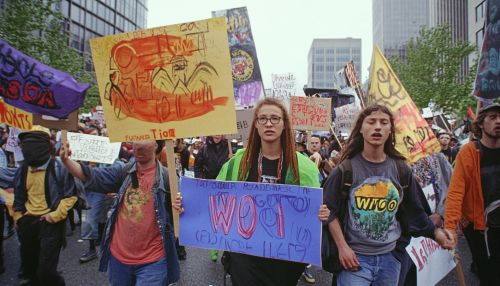Anti-globalization movement
Introduction
The anti-globalization movement is a social and political movement that emerged in the late 20th century as a response to the perceived negative impacts of globalization. It encompasses a diverse array of groups and individuals united by their opposition to the neoliberal policies and practices that promote global economic integration. The movement critiques the influence of multinational corporations, the World Trade Organization (WTO), the International Monetary Fund (IMF), and other global financial institutions, arguing that these entities prioritize profit over people and the environment.
Historical Background
Early Roots
The roots of the anti-globalization movement can be traced back to earlier social movements, such as the labor movement and the environmental movement. These movements laid the groundwork for a broader critique of global economic policies. The labor movement, for instance, has long opposed the exploitation of workers and the erosion of labor rights, while the environmental movement has highlighted the ecological consequences of unchecked industrialization and economic growth.
The 1990s and the Rise of the Movement
The 1990s saw the formal emergence of the anti-globalization movement, catalyzed by several key events. The North American Free Trade Agreement (NAFTA) in 1994 and the establishment of the WTO in 1995 were significant milestones that galvanized opposition. Critics argued that these agreements facilitated the outsourcing of jobs, weakened labor standards, and exacerbated environmental degradation.
The 1999 Seattle WTO protests marked a pivotal moment for the movement, drawing global attention to its cause. Tens of thousands of activists converged in Seattle to protest the WTO's policies, resulting in widespread media coverage and a heightened public awareness of the issues at stake.


Key Issues and Criticisms
Economic Inequality
One of the central criticisms of globalization is its role in exacerbating economic inequality. Activists argue that neoliberal policies, such as trade liberalization and deregulation, disproportionately benefit wealthy nations and multinational corporations at the expense of poorer countries and marginalized communities. The concentration of wealth and power in the hands of a few is seen as a direct consequence of these policies.
Labor Rights
The anti-globalization movement also highlights the adverse effects of globalization on labor rights. The relocation of manufacturing to countries with lower labor costs often leads to the exploitation of workers, poor working conditions, and the erosion of labor protections. The sweatshop phenomenon, where workers are subjected to long hours, low wages, and unsafe conditions, is a focal point of this critique.
Environmental Degradation
Environmental concerns are another major aspect of the movement's critique. The pursuit of economic growth and profit maximization often leads to the over-exploitation of natural resources and significant environmental damage. Deforestation, pollution, and climate change are seen as direct consequences of the global economic system. Activists argue for more sustainable and equitable approaches to development that prioritize environmental stewardship.
Cultural Homogenization
The movement also opposes the cultural homogenization that often accompanies globalization. The spread of Western consumer culture and values is seen as a threat to local traditions, languages, and identities. This cultural imperialism is criticized for undermining the diversity and richness of global cultures.
Notable Events and Protests
Seattle WTO Protests (1999)
The 1999 Seattle WTO protests, also known as the "Battle of Seattle," were a landmark event in the history of the anti-globalization movement. The protests were organized by a coalition of labor unions, environmental groups, and other activists who opposed the WTO's policies. The demonstrations were marked by large-scale civil disobedience, clashes with police, and significant media coverage.
Genoa G8 Summit (2001)
The 2001 Genoa G8 summit in Italy was another significant event for the movement. Tens of thousands of protesters gathered to oppose the policies of the G8 nations, which they argued perpetuated global inequality and environmental destruction. The protests were met with a heavy police response, resulting in violent clashes and the death of a protester, Carlo Giuliani.
World Social Forum
The World Social Forum (WSF) is an annual gathering of social movements, NGOs, and activists from around the world who oppose neoliberal globalization. Established in 2001, the WSF serves as a counterpoint to the World Economic Forum and provides a platform for discussing alternative models of development and global governance.
Organizational Structure and Tactics
Decentralized and Diverse
The anti-globalization movement is characterized by its decentralized and diverse nature. It encompasses a wide range of groups, including labor unions, environmental organizations, human rights groups, and indigenous movements. This diversity is both a strength and a challenge, as it allows for a broad coalition of interests but can also lead to fragmentation and lack of cohesion.
Direct Action and Civil Disobedience
Direct action and civil disobedience are common tactics used by the movement. Protests, sit-ins, and blockades are employed to disrupt the activities of institutions and corporations seen as perpetuating global inequality and environmental harm. These tactics are often aimed at drawing public attention to the issues and forcing policymakers to address the movement's concerns.
Advocacy and Education
In addition to direct action, the movement engages in advocacy and education efforts. This includes lobbying policymakers, raising public awareness through media campaigns, and organizing educational events and workshops. The goal is to build a broad-based movement that can influence public opinion and policy.
Criticisms and Challenges
Internal Divisions
One of the main challenges facing the anti-globalization movement is its internal divisions. The diversity of groups and interests within the movement can lead to disagreements and conflicts over strategy and goals. This lack of unity can weaken the movement's effectiveness and make it difficult to present a coherent alternative to neoliberal globalization.
Public Perception
The movement also faces challenges in terms of public perception. Media coverage of protests often focuses on violence and disruption, which can overshadow the movement's message and alienate potential supporters. Additionally, the complexity of the issues involved can make it difficult to communicate the movement's goals to a broader audience.
Co-optation and Institutionalization
There is also the risk of co-optation and institutionalization. As elements of the movement gain legitimacy and influence, there is a danger that they may be absorbed into the very systems they seek to change. This can lead to a dilution of the movement's radical critique and a loss of momentum.
Future Directions
Building Alliances
One potential direction for the anti-globalization movement is to build stronger alliances with other social movements. By forging connections with movements for racial justice, gender equality, and climate action, the anti-globalization movement can broaden its base of support and amplify its impact.
Emphasizing Positive Alternatives
Another important direction is to emphasize positive alternatives to neoliberal globalization. This includes promoting models of sustainable development, fair trade, and solidarity economy. By presenting viable alternatives, the movement can offer a constructive vision for the future that resonates with a wider audience.
Leveraging Digital Tools
The rise of digital tools and social media offers new opportunities for the movement. These technologies can be used to organize protests, disseminate information, and build global networks of solidarity. However, they also present challenges in terms of surveillance and digital security.
